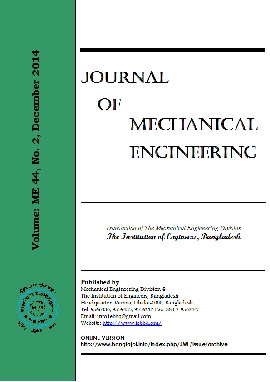EXPERIMENTAL AND ANALYTICAL INVESTIGATION OF THERMAL PARAMETERS DEVELOPED IN HIGH CARBON STEEL JOINTS FORMED BY GTA WELDING
DOI:
https://doi.org/10.3329/jme.v44i2.21420Abstract
This investigation reveals an elaborate analysis of variation of thermal properties of high carbon steelplate butt joints formed by DC Gas Tungsten Arc (GTA) welding. Experiment has conducted to predict the twodimensional temperature cycle developed. To find out the heat flux distribution, Gaussian Heat source model hasbeen implemented. Carslaw-Jaegers mathematical model has been incorporated to estimate the variation ofthermal conductivity. To portray the change in specific heat at different locations from the fusion boundary atexperimental temperatures, Thin plate model has been utilized. Heat loss due to convection, radiation andevaporation have been studied. To estimate total heat loss from weld joint at different locations a method has beenproposed and Vinokurov s empirical correlation has been used for validation. At very close region (36mm fromfusion boundary) to heat affected zone all thermal properties have shown significant variation based onexperimental results. From the analysis of heat loss an optimum temperature has been observed and it is helpful todefine the range of convection and radiation heat loss phenomena.Downloads
Download data is not yet available.
Abstract
303
303
PDF
425
425
Downloads
Published
2015-01-02
How to Cite
Dutta, J., & Narendranath, S. (2015). EXPERIMENTAL AND ANALYTICAL INVESTIGATION OF THERMAL PARAMETERS DEVELOPED IN HIGH CARBON STEEL JOINTS FORMED BY GTA WELDING. Journal of Mechanical Engineering, 44(2), 80–86. https://doi.org/10.3329/jme.v44i2.21420
Issue
Section
Articles

